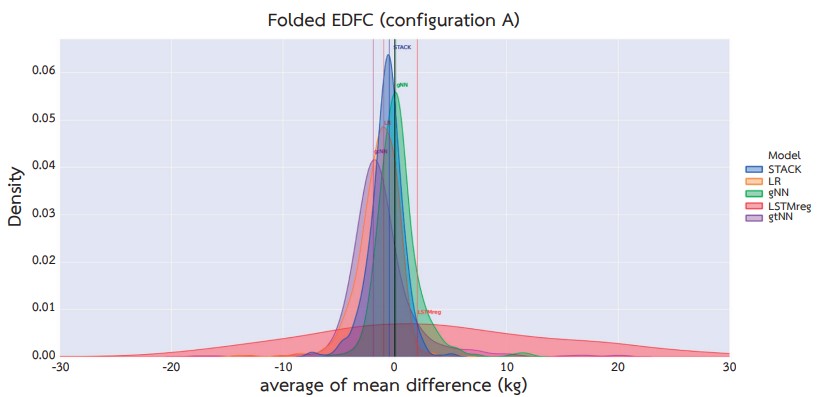Development of an Artificial Intelligence Model for Prediction of Dry Weight in Maintenance Hemodialysis Patients
Main Article Content
Abstract
Background: The optimal dry body weight (DW) for each patient is crucial to the effectiveness of hemodialysis (HD). The traditional assessment of DW using clinical parameters has proven to be inaccurate. Although bioimpedance spectroscopy analysis using Body Composition Monitor (BCM) device demonstrated excellent accuracy but the availability is limited due to high cost. The present study introduced machine learning (ML), a branch of artificial intelligence, in the assessment of DW (ML-DW) using available clinical and laboratory parameters and compared the result with the dry weight derived from BCM (BCM-DW)
Methods: The HD treatment data between 2017 and 2022 from two dialysis centers in Bangkok, Thailand including demographic, laboratory, and intradialytic time-varying data were retrieved. The data on BCM-DW were collected on the same day as HD treatment. The data were used in the ML model development phase and performance assessment phase. There were two groups during the model development phase consisting of a training group and a validation group. The final model was externally validated on a testing group at another institution.
Results: A total of 1151 dialysis sessions accounting for 56,000 time-varying data were retrieved. The mean BCM-DW was 58.8±11.7 kgs and the mean predicted ML-DW from the model was 59.5±10. kgs. The mean difference between ML-DW and BCM-DW was -0.78 (-3.7,2.2) kilograms. The latency for running the model was less than 1 minute.
Conclusion: Despite the relatively large difference between ML-DW and BCM-DW, the present study confirmed the capability of ML in DW prediction.
Article Details

This work is licensed under a Creative Commons Attribution-NonCommercial-NoDerivatives 4.0 International License.
This article is published under CC BY-NC-ND 4.0 license, which allows for non-commercial reuse of the published paper as long as the published paper is fully attributed. Anyone can share (copy and redistribute) the material in any medium or format without having to ask permission from the author or the Nephrology Society of Thailand.
References
Annual Report Thailand Renal Replacement Therapy [Internet]. 2014. Available from: https://www.nephrothai.org/annualreport-thailand-renal-replacement-therapy-2007-2019-th/.
Kraemer M, Rode C, Wizemann V. Detection limit of methods to assess fluid status changes in dialysis patients. Kidney Int. 2006;69(9):1609-20.
Niel O, Bastard P, Boussard C, Hogan J, Kwon T, Deschenes G. Artificial intelligence outperforms experienced nephrologists to assess dry weight in pediatric patients on chronic hemodialysis. Pediatr Nephrol. 2018;33(10):1799-803.
Guo X, Zhou W, Yu Y, Cai Y, Zhang Y, Du A, et al. Multiple Laplacian Regularized RBF Neural Network for Assessing Dry Weight of Patients With End-Stage Renal Disease. Front Physiol. 2021;12:790086.
Guo X, Zhou W, Lu Q, Du A, Cai Y, Ding Y. Assessing Dry Weight of Hemodialysis Patients via Sparse Laplacian Regularized RVFL Neural Network with L(2,1)-Norm. Biomed Res Int. 2021;2021:6627650.
Chiu JS, Chong CF, Lin YF, Wu CC, Wang YF, Li YC. Applying an artificial neural network to predict total body water in hemodialysis patients. Am J Nephrol. 2005;25(5):507-13.
National Kidney F. K/DOQI clinical practice guidelines for chronic kidney disease: evaluation, classification, and stratification. Am J Kidney Dis. 2002;39(2 Suppl 1):S1-266.
Donadio C, Halim AB, Caprio F, Grassi G, Khedr B, Mazzantini M. Single- and multi-frequency bioelectrical impedance analyses to analyse body composition in maintenance haemodialysis patients: comparison with dual-energy x-ray absorptiometry. Physiol Meas. 2008;29(6):S517-24.
Carter M, Morris AT, Zhu F, Zaluska W, Levin NW. Effect of body mass index (BMI) on estimation of extracellular volume (ECV) in hemodialysis (HD) patients using segmental and whole body bioimpedance analysis. Physiol Meas. 2005;26(2):S93-9.
Agarwal R, Bouldin JM, Light RP, Garg A. Probing dry-weight improves left ventricular mass index. Am J Nephrol. 2011;33(4):373-80.
Agarwal R, Alborzi P, Satyan S, Light RP. Dry-weight reduction in hypertensive hemodialysis patients (DRIP): a randomized, controlled trial. Hypertension. 2009;53(3):500-7.
Jian Y, Li X, Cheng X, Chen Y, Liu L, Tao Z, et al. Comparison of bioimpedance and clinical methods for dry weight prediction in maintenance hemodialysis patients. Blood Purif. 2014;37(3):214-20.


